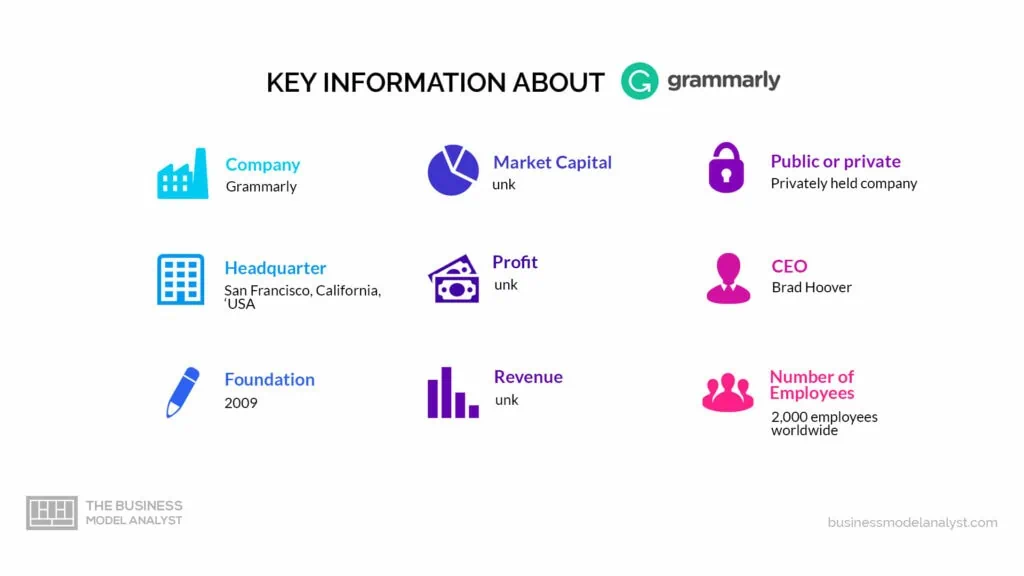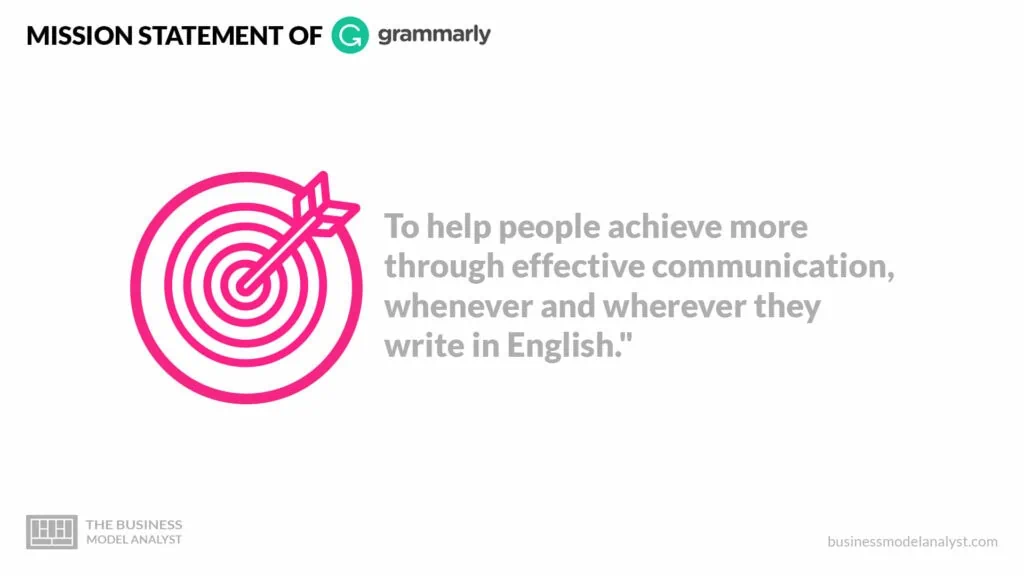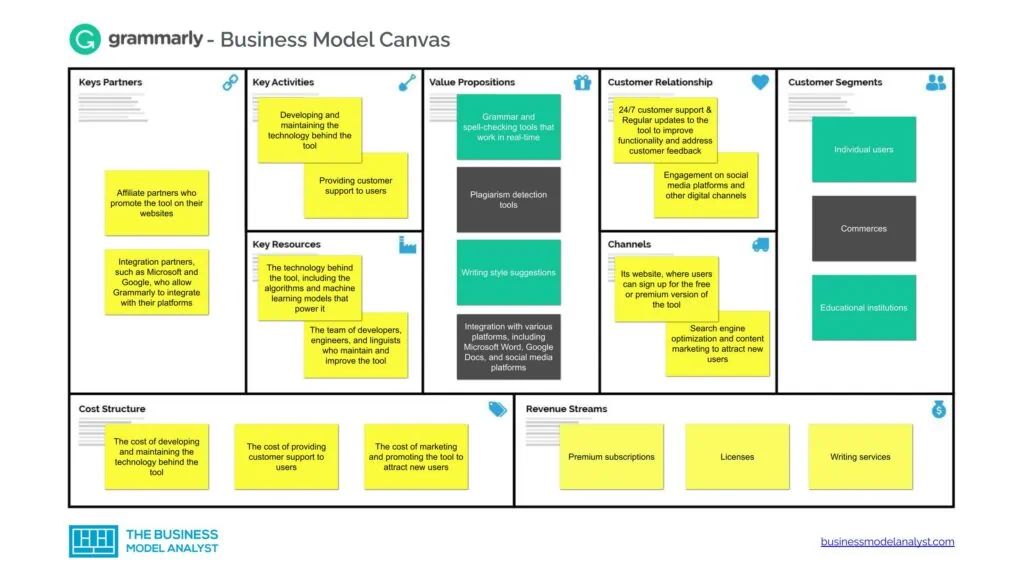Grammarly is based on a subscription-based freemium business model. This model allows users to access the core features of the product for free, while offering additional features and services for a fee. The Grammarly business model has proven to be a successful business strategy, since the company has achieved a valuation of over $1 billion and has attracted millions of users worldwide. By offering a free version of its product, Grammarly has been able to build a large user base and establish itself as a leader in the writing assistant market.
So, how exactly does Grammarly make money? In this article, we will dissect the Grammarly Business Model and explore the various revenue streams that have contributed to the company’s success. We will examine the different customer segments that Grammarly targets and the pricing strategies that the company employs. By the end of this article, you will have a clear understanding of how Grammarly’s business model works and what has made it so successful.

Contents
A brief history of Grammarly
Grammarly is an online writing assistant that was founded in 2009 by Ukrainian developers Alex Shevchenko and Max Lytvyn. Initially, the duo created the software to help non-native English speakers improve their writing skills. However, they soon realized that their product could help anyone who wanted to write better, regardless of their English language proficiency.
Over the years, Grammarly has evolved into a comprehensive writing tool that uses artificial intelligence and natural language processing to help users write better. The software checks for grammar, spelling, punctuation, and style errors, and provides suggestions to improve the clarity and effectiveness of the writing.
In 2012, Grammarly launched its browser extension, which allowed users to check their writing in real-time on popular websites like Facebook, Twitter, and LinkedIn. This feature proved to be popular among users and helped Grammarly gain a wider audience.
Since then, Grammarly has continued to innovate and expand its offerings. In 2017, the company launched Grammarly for Microsoft Office, which allowed users to check their writing in Word and Outlook. In 2019, Grammarly introduced a tone detector, which helps users ensure that their writing conveys the appropriate tone for the intended audience.
Today, Grammarly has over 20 million users worldwide and has become a go-to tool for anyone who wants to improve their writing skills. The company’s success can be attributed to its commitment to innovation and its focus on providing a high-quality user experience.
Who Owns Grammarly
Grammarly is a privately held company, and its ownership is split between several investors and its founders. According to Forbes, about 22% of the company is owned by investors who participated in its funding rounds in 2019 and 2021. The remaining shares are held by the company’s co-founders, Max Lytvyn and Alex Shevchenko.
Lytvyn and Shevchenko launched Grammarly in 2009. The two Ukrainian entrepreneurs met while studying computer science at Kyiv Polytechnic Institute. They started working on Grammarly while pursuing graduate degrees at Carnegie Mellon University in Pittsburgh.
In its early days, Grammarly struggled to find investors. The company was rejected by several venture capital firms before securing seed funding from angel investors. However, the company’s fortunes changed when it launched its browser extension in 2012. The extension quickly gained popularity, and the company was able to secure additional funding.
Today, Grammarly is one of the most popular writing tools on the market. Its success has made Lytvyn and Shevchenko billionaires. However, the company’s ownership structure means that they are not the only ones who benefit from its success. The investors who have backed Grammarly also stand to profit if the company continues to grow and expand its user base.
Grammarly Mission Statement

The Grammarly’s mission statement is “to help people achieve more through effective communication, whenever and wherever they write in English.”
How Grammarly works
Grammarly is a writing assistant that helps users improve their writing skills. It works by offering suggestions for grammar, spelling, punctuation, and style errors. The tool is available as a browser extension, a desktop app, and a mobile app.
Grammarly uses a combination of rule-based and machine-learning algorithms to analyze text. The tool checks for errors in real-time and offers suggestions for corrections. It also provides explanations for the suggested changes, helping users understand why the changes are necessary.
The tool offers a free version and a premium version. The free version checks for basic grammar and spelling errors, while the premium version offers more advanced features such as style suggestions, vocabulary enhancement, and plagiarism detection.
Grammarly also offers writing services provided by real humans. These services include proofreading, editing, and writing assistance. Users can submit their documents to Grammarly’s team of professional writers and editors for review and feedback.
How Grammarly makes money
Grammarly is a popular writing assistant tool that uses artificial intelligence to help people improve their writing skills. The company uses a freemium model to sell premium writing subscriptions to three different customer segments: individual users, businesses, and educational institutions.
Premium Subscriptions
Individual users can access Grammarly’s basic features for free. Still, they can upgrade to premium for more advanced features such as plagiarism detection, vocabulary enhancement suggestions, and genre-specific writing style checks. Premium subscriptions are available on a monthly, quarterly, or annual basis.
Businesses can purchase Grammarly Business, which offers team management tools, priority email support, and centralized billing. The price varies depending on the number of users and the length of the subscription.
Educational institutions can purchase Grammarly@edu, which provides access to Grammarly’s premium features for students and faculty. The pricing is based on the number of users and the length of the subscription.
Licenses
In addition to subscriptions, Grammarly also generates revenue by licensing its software to universities and offering expert writing services. These services include professional proofreading, editing, and writing support for businesses and individuals.
Writing Services
Lastly, Grammarly generates revenue through professional writing services, which are provided by real humans.
Grammarly Business Model Canvas

Grammarly Customer Segments
Grammarly targets three main customer segments:
- Individual users, who use the free or premium version of the tool;
- Commerces that purchase the premium version for their employees;
- Educational institutions that purchase the premium version for their students.
Grammarly Value Propositions
Grammarly offers a range of value propositions to its customers, whether we’re talking about individual users, commerces, or educational institutions. They are:
- Grammar and spell-checking tools that work in real-time;
- Plagiarism detection tools;
- Writing style suggestions;
- Integration with various platforms, including Microsoft Word, Google Docs, and social media platforms;
- 24/7 customer support.
Grammarly Channels
Grammarly primarily uses digital channels to reach its customers, including:
- Its website, where users can sign up for the free or premium version of the tool;
- Search engine optimization and content marketing to attract new users;
- Social media platforms to engage with users and promote the tool;
- Affiliate marketing to reach new customers through partnerships with other websites.
Grammarly Customer Relationships
Grammarly maintains customer relationships through:
- 24/7 customer support;
- Regular updates to the tool to improve functionality and address customer feedback;
- Engagement on social media platforms and other digital channels.
Grammarly Revenue Streams
Grammarly generates revenue through:
- Premium subscriptions
- Licenses
- Writing services
Grammarly Key Resources
Grammarly’s key resources include:
- The technology behind the tool, including the algorithms and machine learning models that power it;
- The team of developers, engineers, and linguists who maintain and improve the tool;
- The customer support team that assists users.
Grammarly Key Activities
Grammarly’s key activities include:
- Developing and maintaining the technology behind the tool;
- Providing customer support to users;
- Marketing and promoting the tool to attract new users.
Grammarly Key Partners
Grammarly’s key partners include:
- Affiliate partners who promote the tool on their websites;
- Integration partners, such as Microsoft and Google, who allow Grammarly to integrate with their platforms.
Grammarly Cost Structure
This is the Grammarly’s Cost Structure:
- The cost of developing and maintaining the technology behind the tool;
- The cost of providing customer support to users;
- The cost of marketing and promoting the tool to attract new users.
Grammarly Competitors
Grammarly is a popular online writing and grammar-checking platform that competes with other similar platforms. Some of the biggest competitors of Grammarly include:
- ProWritingAid: This is one of the biggest competitors of Grammarly, offering similar features and tools for grammar checking, writing style analysis, and more. ProWritingAid is more suitable for long-form content, but it is also an excellent option for shorter formats;
- Microsoft Word and Apple Pages: These are built-in grammar checkers that offer many of the same tools you get with Grammarly. However, they are not as comprehensive as Grammarly and do not offer as many advanced features;
- WhiteSmoke: This is another popular grammar checker that provides a range of features, including grammar checking, plagiarism detection, and more. However, it is not as user-friendly as Grammarly and can be challenging to navigate;
- Ginger: This is a grammar checker that offers similar features to Grammarly, including grammar checking, spelling correction, and more. However, it is not as comprehensive as Grammarly and does not offer as many advanced features.
Grammarly SWOT Analysis

Grammarly Strengths
- Solid reputation and recognition: Grammarly has established itself as a leading provider of grammar and writing tools. It has a strong following of loyal users who rely on its services to improve their writing skills. The company has built a strong brand reputation and recognition, which has helped it to expand its user base and increase its revenue;
- Free trial of paid subscription: Grammarly’s freemium business model has also been a key strength, as it allows users to try the service for free before upgrading to a paid plan. This has helped the company to attract a large number of users and to generate significant revenue from its premium plans.
Grammarly Weaknesses
- Reliability in AI and machine-learning algorithms: One of the main weaknesses of Grammarly is its reliance on machine-learning algorithms to detect errors in writing. While these algorithms are highly effective, they are not perfect and can sometimes miss errors or provide incorrect suggestions. This can lead to frustration among users and may cause them to switch to competing services;
- Lack of support for languages other than English: Another weakness of Grammarly is its lack of support for certain languages and dialects. The service is primarily designed for English-speaking users, which may limit its appeal to non-English speakers or users who speak English as a second language.
Grammarly Opportunities
- New ideas for its users: Taking advantage of its enormous market share, Grammarly can develop new products and features to meet the needs of its users;
- Expansion for new languages: Grammarly has a vast range of opportunities when it comes to expanding the software to new languages other than English;
- Partnerships: The company could also explore partnerships with other companies to integrate its services into its products or to offer bundled services to customers;
- New markets: Another opportunity for Grammarly is to expand its user base by targeting new markets, such as students, professionals, and non-native English speakers;
- New channels of distribution: The company could also explore new distribution channels, such as social media and mobile apps, to reach a wider audience.
Grammarly Threats
- High competition: One of the main threats to Grammarly is competition from other grammar and writing tools. There are several competing services available, some of which offer similar features and pricing models. This competition could lead to a decrease in Grammarly’s market share and revenue;
- Potential cyberattacks and data breaches: Another threat to Grammarly is the risk of data breaches or other security issues. The company collects a large amount of user data, including writing samples and personal information, which could be vulnerable to cyberattacks or other security breaches. This could damage the company’s reputation and lead to a loss of user trust.
Conclusion
Grammarly’s business model is based on providing software that helps users improve their grammar skills. The company has a subscription-based model, where users pay a monthly fee to use the software. In addition to selling premium writing subscriptions, the company also generates revenue by selling its human proofreading service.
Grammarly’s initial focus was on developing a grammar checker tool for use in web browsers, but it has since expanded to offer a range of tools to improve writing. The company targets three different customer segments: individual users, businesses, and educational institutions, using a freemium model to sell premium writing subscriptions.
Despite raising more than $200 million in venture capital investment, experts suggest that Grammarly is not yet profitable. Nevertheless, the company is one of the “VC unicorns” of the tech boom over the last decade.
Overall, Grammarly’s business model is successful in providing a valuable service to its customers, and its expansion into a range of tools to improve writing has allowed the company to target a broader audience. However, the company’s profitability remains a concern, and it will be interesting to see how the company continues to grow and evolve in the future.

